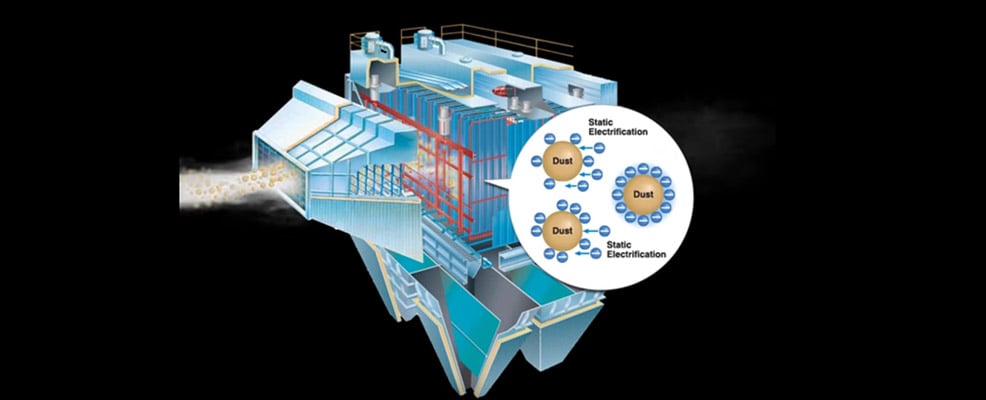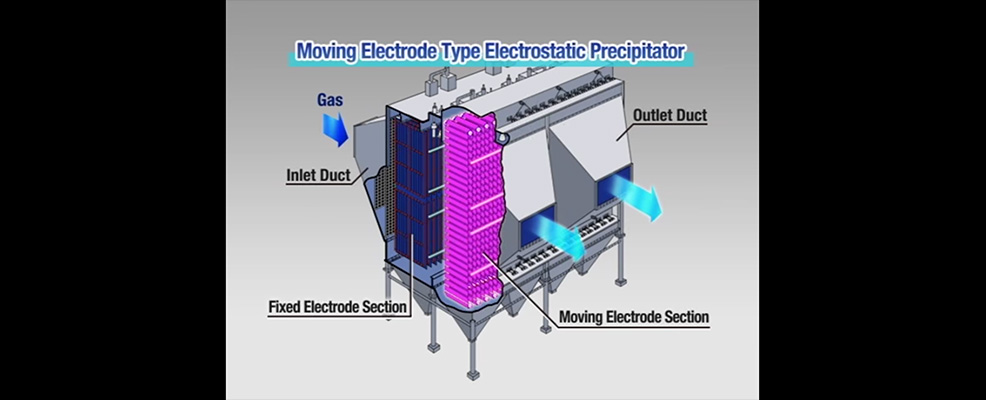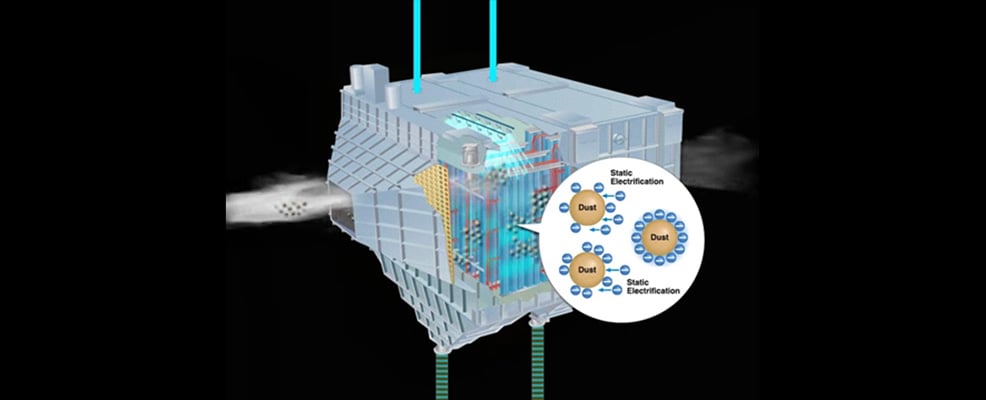Electrostatic Precipitators (ESP)
-
Maximum Capacity
1,050 MW
-
Lowest Dust Emission
Dry ESP : ≤ 10mg/m3N
Wet ESP: ≤ 1mg/m3N -
Wide Application Range
⋅ Moving Electrode Type ESP
⋅ Pulse Energization -
High Reliability
Electrostatic precipitators (ESP) collect dust in the flue gas produced by boiler, etc. Mitsubishi Power contributes to air pollution control at thermal power plants, steel plants , and various industrial plants.
Basic Principle of ESP
A high voltage is applied to the discharge electrode, generating a corona discharge that produces minus ions. The electrically charged dust is accumulated on the collecting electrode by an electrical field.
The accumulated dust is removed by rapping hammer (dry ESP), scraping brush (dry ESP), or flushing water (wet ESP).

Dust Collection Performance and Dust Characteristics
Our accumulated know-how in evaluating characteristic assessments on various dust properties and flue gas conditions, together with extensive field experience, are reflected in the ESP design.

ESP Performance Improvements to counter High-Resistivity Dust
The most important consideration in ESP for coal-fired boiler applications is to maintain and increase the dust collecting performance of high-resistivity dust. Several improvements to counter high-resistivity dust have been established based on the investigation into the mechanism of back corona phenomenon.
Our technologies are shown in the following table. We can offer suitable technologies for plant applications and operations and can realize both compact design and high efficiency.
| Countermeasure | Method | Our Technologies |
|---|---|---|
| (1) Dust layer Removal | Removing Dust on Electrode Completely | Moving Electrode Type ESP |
| Wet ESP | ||
| (2) Resistivity Decreasing | Decreasing Gas Temperature | High Efficiency AQCS (Low Low Temp. ESP) |
| (3) Current Control of Dust layer | Electrical Energization Control | Intermittent Energization |
| Pulse Energization |


Mechanism to Remove Dust Collected on Collecting Plate
Fixed-electrode type ESP and moving-electrode type ESP use the following method to remove collected dust.
Fixed Electrode Type
A collecting electorode rapping device is used to remove the dust collected on the collecting electrode.

Moving Electrode Type
Collecting electrodes are divided into short strip elements that are joined by chains, and the collecting electrodes are moved slowly.
The dust collected on the collecting electrode elements is completely scraped off by brushes provided in the hoppers.

Structure of Fixed Electrode Type ESP
External Structure

Internal Structure


Video: Fixed Electrode Type Electrostatic Precipitator
Moving Electrode Type Electrostatic Precipitator (MEEP)
Effective Collection of High-Resistivity Dust
Mitsubishi Power moving electrode electrostatic precipitators incorporate a new system developed to dislodge collected dust by movable collecting plates and brushes.
These systems are also compact thanks to their high collection performance.
Structure of Moving Electrode Type ESP


Video: Moving Electrode Type Electrostatic Precipitator
Features of Wet Electrostatic Precipitator
- Suitable for applications requiring a much higher degree of gas purity at outlet than can be readily achieved by dry type ESP.
- Using water in removing the collected dust, the wet type ESP can achieve high dust removal efficiency (down to 1 mg/m3N) without being affected by the high or low electrical resistivity of dust.
Structure of Wet Type Electrostatic Precipitator


Video: Wet Electrostatic Precipitator
Products
- GTCC
- Steam Power
- IGCC
- Geothermal
-
Gas Turbines
- Product Lineup
- Comparative Performance
-
Technical Information
- Gas Turbines for Mechanical Drive Applications
- Cutting-Edge Elemental Technology Producing 1600°C Class J Gas Turbines
- Development of High-Efficiency Gas Turbine Applying 1600°C Class J Technology
- Combustor Technologies Supporting Stable Operation
- Overview and Verification Status of T-Point 2 Demonstration Facility
- Comprehensive Efforts from Development to Manufacturing
- Summary of Orders
- Development History
- Product Selection Assistant (Middle & small Class)
- Aero-derivative Gas Turbines
- Steam Turbines
- Boilers
- Air Quality Control Systems (AQCS)
- Generators
-
Control Systems
- What is DIASYS?
- DIASYS Netmation
-
DIASYS Optional Products
- IR-S Infrared Flame Detector
- Net IR-S Infrared Flame Detector
- Rail Mounting Net IR-S
- Boiler Tube Leak Detector
- Shaft Vibration Analyzer
- Simulator
- Advanced Combustion Pressure Fluctuation Monitoring System (A-CPFM) / Combustion Pressure Fluctuation Monitoring System (CPFM)
- Multi-Coal Fired Boiler Optimum Control
- FXtoLS Adapter
- Fuel Cells
- Additive Manufacturing
- Catalogue
- HIACS Series
- Technical Report